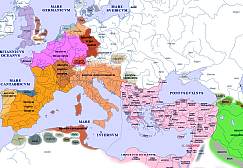

An Online Encyclopedia of Roman Emperors
Gregoria (Wife of Heraclius Constantine)
Lynda Garland
University of New England, New South Wales Shortly after his baptism and coronation on 22 January 613, Heraclius's son and heir, the one-year-old Heraclius Constantine, was betrothed to his cousin Gregoria. His fiancée was the daughter of the general Nicetas, whom Heraclius had recently honoured with the rank of patrician. Nicetas, Heraclius's first cousin (the son of Heraclius's uncle Gregorius), had been a moving force in Heraclius's coup d' état and by the betrothal and marriage of Heraclius Constantine to his second cousin the two halves of the family were united in imperial power. As the couple were second cousins, the marriage was technically incestuous, but this consideration must have been outweighed by the advantages of the match to the family as a whole. Furthermore, its illegality paled into insignificance beside the emperor's marriage to his niece Martina which was to take place in 613 or 614. Gregoria's father Nicetas had taken part in the conquest of Egypt from Phocas, had been governor of Egypt, and was famed for bringing the Holy Sponge and Holy Lance to Constantinople from Palestine in 612; from 619 to 628/9 he appears to have been exarch of Africa.[[1]]
Gregoria's marriage took place in 629 or perhaps early 630, at the same time as that of Theodosios, one of Heraclius Constantine's younger half-brothers, to Nike, the daughter of the Persian general Shahrvaraz. Gregoria was brought from Pentapolis in Libya for the occasion: hence she does not seem to have been brought up in the palace with her fiancée but to have lived with her father, who had recently died, perhaps in 629.[[2]] Their eldest child, Flavius Heraclius, who was later crowned emperor under the name Constantine and was to be known as Constans, was born on 7 November 630.[[3]] The date of birth of a second son, Theodosius, is unknown; Theodosius was killed by his elder brother in 658/9.[[4]]
In 641 Gregoria's husband, Heraclius Constantine, was to succeed to the throne only briefly. After three or four months on the throne with his co-ruler and half-brother Heraclonas, he died, probably of tuberculosis. He was succeeded by the regime of Heraclonas and his mother Martina. On their deposition a few months later, probably in September 641, Gregoria's son Constantine came to power as Constans II and reigned from 641 to 668, though he did not assume real power until about 650. During the period prior to 650 Gregoria must have played an important role as regent for her son. She was not only the widow of Heraclius Constantine, and thus empress-dowager, but, as the daughter of Heraclius's cousin Niketas, a member of the Heraclean dynasty in her own right. As such she must have been involved in the conflicts between her husband and his step-mother and between the champions of her son Constans and those of his uncle Heraclonas. Indeed, it would be unrealistic to suppose that Gregoria was prepared to tolerate either Martina's imperial ambitions for her children and the supplanting of her own, or Martina's attempt to dominate the political scene after Heraclius's death. Martina's unpopularity as both empress and regent had been such that Gregoria, as mother of the young emperor, doubtless found it wise to minimise her overt involvement in government, but that does not imply that she did not have considerable influence over events. The sources, however, ignore the part she played in Constans's early reign and the details of her death are not known.
Bibliography:
Garland, L. Byzantine Empresses: Women and Power in Byzantium, AD 527-1204. London: Routledge, 1999, pp. 61-72.
Haldon, J.F. Byzantium in the Seventh Century. The Transformation of a Culture, Cambridge, 1990.
Kaegi, W.E. 'New Evidence on the Early Reign of Heraclius', Byzantinische Zeitschrift, 66 (1973), 308-30.
________. Byzantine Military Unrest, Amsterdam, 1981.
________. Byzantium and the Early Islamic Conquests, Cambridge, 1992.
Stratos, A.N. Byzantium in the Seventh Century, vols. 2 & 3, Amsterdam.
[[1]]Chronicon Paschale, 703; Nicephorus, Short History, 2; Theophanes, Chronographia, AM 6102 [AD 609/10].
[[2]]Nicephorus, 1, 2, 5, 17; Theophanes, AM 6118, 6120 [AD 625/6, 627/8]; cf. John of Antioch, Excerpta de insidiis, chap. 149. According to the Life of Theodore of Sykeon, 154, Nicetas in 612 was healed of paralysis by the saint, after having been poisoned. Nicetas also features prominently in the Life of St John the Almsgiver and was apparently his adopted brother (ed. and French tr. by A.-J. Festugière, Vie de Syméon le Fou et Vie de Jean de Chypre, Paris, 1974; English tr. by E. Dawes & N.H. Baynes, Three Byzantine Saints, 1948; repr. Crestwood, 1977, 195-270).
[[3]]Theophanes, AM 6122 [AD 629/30].
[[4]]Ibid., AM 6150.
Copyright (C) 2000, Lynda Garland. This file may be copied on the condition that the entire contents, including the header and this copyright notice, remain intact.
Comments to: Lynda Garland.
Updated:30 January 2000
For more detailed geographical information, please use the DIR/ORBAntique and Medieval Atlas below. Click on the appropriate part of the map below to access large area maps.
